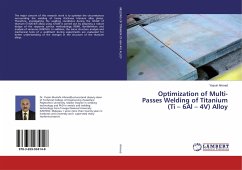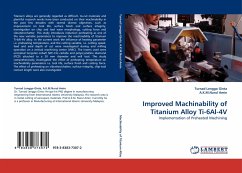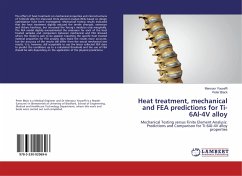
Fretting Fatigue Behavior of a Titanium Alloy Ti-6AL-4V at Elevated Temperature
Versandkostenfrei!
Versandfertig in über 4 Wochen
29,99 €
inkl. MwSt.
Weitere Ausgaben:

PAYBACK Punkte
15 °P sammeln!
Fretting fatigue crack initiation in titanium alloy, Ti-6Al-4V, at elevated temperature is investigated experimentally and analytically using finite element analysis. The temperature of this study is chosen to be 260 oC. Several specimens are tested at different stress levels to establish the life data (i.e. S-N relationship). The crack initiation location and the crack angle orientation along the contact surface are determined using scanning electron microscopy. Finite element analysis is used to obtain the stress states for the experimental conditions used during the fretting fatigue tests. ...
Fretting fatigue crack initiation in titanium alloy, Ti-6Al-4V, at elevated temperature is investigated experimentally and analytically using finite element analysis. The temperature of this study is chosen to be 260 oC. Several specimens are tested at different stress levels to establish the life data (i.e. S-N relationship). The crack initiation location and the crack angle orientation along the contact surface are determined using scanning electron microscopy. Finite element analysis is used to obtain the stress states for the experimental conditions used during the fretting fatigue tests. These are then used to investigate several critical plane based multi-axial fatigue parameters. These parameters are evaluated based on their ability to predict the crack initiation location, crack orientation angle along the contact surface, and the number of cycles to fretting fatigue crack initiation. These predictions are compared with their experimental counterparts to characterize the role of normal and shear stresses on fretting fatigue crack initiation at elevated temperature. Also, plain and fretting fatigue data at room and elevated temperature are compared. From these comparisons, it can be concluded that 260 temperature does not have any detrimental effect on fretting fatigue crack initiation of Ti-6Al-4V when compared to that at room temperature. Further, fretting fatigue crack initiation mechanism in the tested titanium alloy appears to be governed by the shear stress on the critical plane. However, further work is needed to understand the role of both shear and normal stresses on the critical plane at elevated temperatures. This work has been selected by scholars as being culturally important, and is part of the knowledge base of civilization as we know it. This work was reproduced from the original artifact, and remains as true to the original work as possible. Therefore, you will see the original copyright references, library stamps (as most of these works have been housed in our most important libraries around the world), and other notations in the work. This work is in the public domain in the United States of America, and possibly other nations. Within the United States, you may freely copy and distribute this work, as no entity (individual or corporate) has a copyright on the body of the work. As a reproduction of a historical artifact, this work may contain missing or blurred pages, poor pictures, errant marks, etc. Scholars believe, and we concur, that this work is important enough to be preserved, reproduced, and made generally available to the public. We appreciate your support of the preservation process, and thank you for being an important part of keeping this knowledge alive and relevant.












